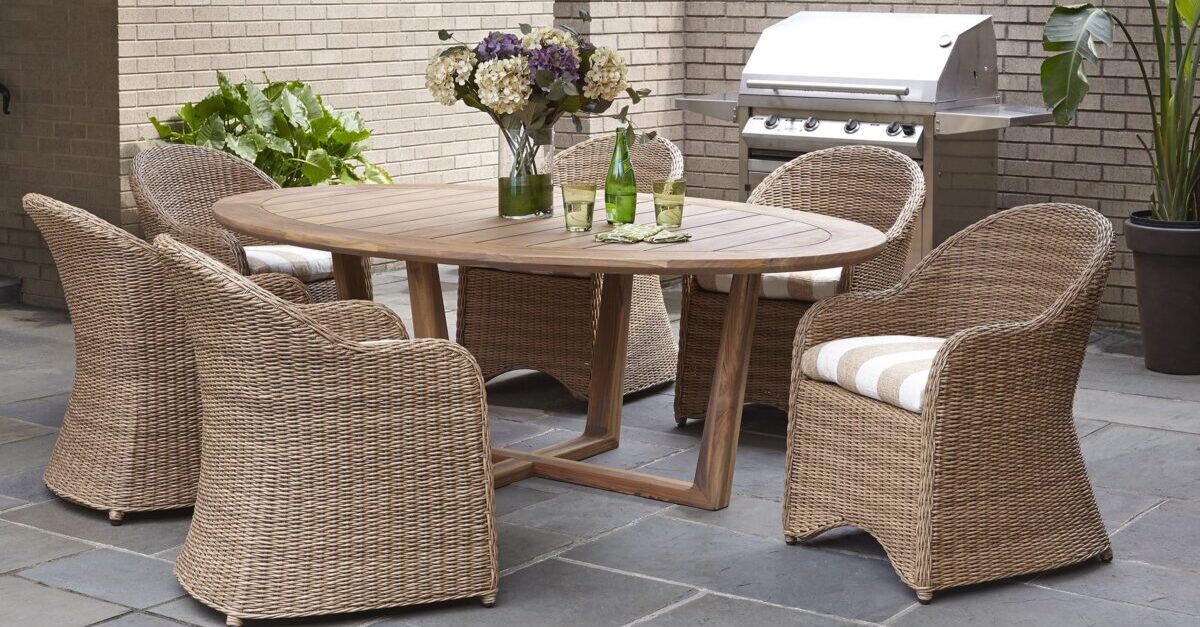If you have ever wondered about what wicker is, you are not alone. Many people are curious about the origin, meaning, and uses of wicker, especially when it comes to furniture and baskets.
Wicker is a method of weaving that can create various products from different materials. In this article, we will help you learn more about this fascinating craft.
Let’s get started!

Table of contents
- What is the History of Wicker?
- What is the Difference Between Wicker and Rattan?
- What are the Advantages of Wicker?
- What are the Disadvantages of Wicker?
- How to Choose the Best Wicker Furniture?
- How to Clean and Care for Wicker Furniture?
- How to Repair and Restore Wicker Furniture?
- How to Decorate with Wicker Furniture?
- What are the Trends and Innovations in Wicker Furniture?
- Where to Buy Wicker Furniture?
- FAQs
- Conclusion
- References
- Recommendations
What is the History of Wicker?
Wicker is a weaving technique that has been used for thousands of years to create various products from different materials. The word actually comes from the Old English word “wicca”, which means to bend or twist.
It was first documented in ancient Egypt, where it was made from pliable plant materials such as reeds and grasses. Wicker was also used by other ancient civilizations, such as Persia, Rome, and China, for making items such as baskets, chairs, chests, and shields.
It became popular in Europe in the 16th and 17th centuries, and later in America, where it was used for both indoor and outdoor furniture. It also influenced the development of Celtic art, which is known for its intricate woven patterns.
Wicker is still widely used today, as it is a versatile, durable, and eco-friendly material that can be shaped into various forms and styles. It is one of the oldest and most fascinating crafts in the world, and it has a long and rich history that reflects the culture and creativity of its makers.
See also: Grants for Furniture and Carpets in the UK | | Requirements
What is the Difference Between Wicker and Rattan?
Wicker and rattan are often confused, but they are not the same thing. Wicker is a weaving technique, while rattan is a material.
Furthermore, wicker can be made from various natural or synthetic materials, such as bamboo, reed, vinyl, or resin. Rattan is a type of climbing palm plant that grows in tropical regions, such as Southeast Asia and Africa. However, rattan has a strong and flexible stem that can be split into thin strips and woven into wicker products. Rattan is one of the most common materials for wicker, but not the only one.
The difference between both of them affects their durability, appearance, and eco-friendliness. Rattan furniture is more durable than wicker furniture, as it has a solid core and can withstand weather elements better.
Wicker furniture is more versatile than rattan furniture, as it can be shaped into various forms and styles, from traditional to modern. Rattan furniture is more eco-friendly than wicker furniture, as it is made from renewable and biodegradable resources, such as plants and fibers.
Wicker and rattan are both popular for lightweight, stylish furniture, but rattan is considered more long-lasting and sustainable. Therefore, depending on your preference and purpose, you can choose the best option for your home décor.
See also: Disability Grants For Furniture In The UK | 2024 Requirements
What are the Advantages of Wicker?
Wicker is a material that has many advantages for furniture and decoration. Wicker is a weaving technique that can create various products from different natural or synthetic materials, such as rattan, bamboo, vinyl, or resin.
Some of the benefits of wicker are:
- It is lightweight, yet sturdy and durable, making it easy to move and store.
- It is versatile, as it can be shaped into various forms and styles, from traditional to modern.
- It is eco-friendly, as it is made from renewable and biodegradable resources, such as plants and fibers.
- It is comfortable, as it allows air circulation and conforms to the body shape.
- It is aesthetically pleasing, as it adds a natural and cozy touch to any space.
- It is a material full of advantages that can enhance the beauty and comfort of your home.
- It can be used for both indoor and outdoor furniture, depending on the type of material.
Natural wicker is more suitable for indoor use, as it requires protection from weather elements, such as moisture, sunlight, and mold. Synthetic wicker is more suitable for outdoor use, as it is resistant to weather, moisture, sunlight, and fading.
See also: What’s the Best Type of Adhesive for Vinyl Floors?
What are the Disadvantages of Wicker?
Wicker also has some drawbacks that need to be considered before buying or using it. Some of the disadvantages of wicker are:
- It is susceptible to damage from moisture, sunlight, insects, and mold, especially if it is made from natural materials.
- It requires regular maintenance and cleaning, such as dusting, wiping, and applying protective coatings, to prevent deterioration and fading.
- It can be expensive, depending on the quality, design, and craftsmanship of the wicker products.
- It can be uncomfortable if it is not cushioned or padded, as it can cause scratches or splinters.
See also: 7 Things Exterminators Check During Termite Inspections
How to Choose the Best Wicker Furniture?
Wicker furniture is a great option for outdoor and indoor spaces, as it is lightweight, versatile, comfortable, and eco-friendly. However, not all furniture is created equal, and there are some factors to consider before buying it.
Here are some tips on how to choose the best wicker furniture for your home:
#1. Decide on the Purpose and Location of the Furniture
It can be used for both outdoor and indoor use, but you need to choose the right type of material for each setting.
Natural wicker, such as rattan, bamboo, or reed, is more suitable for indoor use, as it is more breathable and cozy, but it requires protection from weather elements, such as moisture, sunlight, and mold.
Synthetic wicker, such as vinyl or resin, is more suitable for outdoor use, as it is more durable, weather-resistant, and easy to maintain.
See also: Is Memorial Day the Best Time to Buy Furniture?
#2. Check the Quality and Durability of the Wicker
It should have a thick and sturdy frame, preferably made of aluminum, to provide support and stability. The frame should also be powder-coated to prevent rust and enhance the appearance.
The wicker material should be woven tightly and evenly, without any gaps, splinters, or warps. It should also come with a warranty or guarantee from the manufacturer or seller.
See also: What to Pack When Moving Out Of Your Parent’s House | 10+ Simple Steps
#3. Choose the Style and Design of the Wicker Furniture
It comes in various forms and styles, from traditional to modern, and you should choose the one that matches your personal taste and preference, as well as the theme and decor of your space. You should also consider the size, shape, color, and texture of the wicker furniture, and how they fit with your existing furniture and accessories.
You can also add cushions, pillows, throws, or rugs to wicker furniture, to make it more comfortable and cozier. Choose colors and patterns that complement or contrast with the wicker furniture.
See also: Why is My Bedroom So Dusty? 5 Reasons According to Cleaning Experts
How to Clean and Care for Wicker Furniture?
Wicker furniture is a great option for outdoor and indoor spaces, as it is lightweight, versatile, comfortable, and eco-friendly. However, wicker furniture also requires proper cleaning and care to keep it in good condition and extend its lifespan. Here are some tips on how to clean and care for wicker furniture:
Vacuum the furniture regularly, using a brush attachment to remove dust and pollen from the crevices. This will prevent the accumulation of dirt and organic material that can cause mildew and decay.
Spot-clean the furniture with a solution of mild dish detergent and warm water, using a sponge or an old toothbrush. This will remove stains and spills that can damage the wicker material. Rinse well and let the furniture dry completely before using it.
For deeper cleaning, hose down the furniture with water and scrub it with a soft-bristle brush and soapy water. This is especially recommended for synthetic wicker, which is more resistant to water and weather. Dry the furniture thoroughly with a towel or a fan.
Apply a protective coating, such as lacquer, varnish, or paint, to the furniture, to seal and preserve its color and shine. Follow the instructions and recommendations of the manufacturer or seller for the best results.
Store the furniture in a cool, dry, and well-ventilated place, away from direct sunlight, heat, and moisture. Cover the furniture with a cloth or a plastic sheet, or use covers designed for wicker furniture, to protect it from dust and dirt.
See also: What is a Caterer? Difference between a Caterer and a Chef
How to Repair and Restore Wicker Furniture?
Wicker furniture can be repaired and restored if it is damaged or worn out.
Here are some steps on how to repair and restore wicker furniture:
- Inspect the furniture for any broken, loose, or missing strands, and mark them with tape or a marker.
- Remove the old and damaged strands with a pair of scissors or a knife, and discard them.
- Soak the new strands in water for about 30 minutes, to make them pliable and flexible.
- Weave the new strands into the furniture, following the original pattern and direction. Use a needle or tweezers to help you insert and pull the strands through the gaps.
- Cut the excess strands and tuck the ends into the furniture, using glue or nails to secure them.
- Repeat the process until all the damaged areas are repaired and restored.
See also: How to Make Homemade Dog Repellent
How to Decorate with Wicker Furniture?
Wicker furniture can be used to decorate any space, from living rooms to bedrooms, from patios to porches. Here are some ideas on how to decorate with wicker furniture:
- Mix and match the furniture with other types of furniture, such as wood, metal, or leather, to create a contrast and balance.
- Add cushions, pillows, throws, or rugs to the furniture, to make it more comfortable and cozy. Choose colors and patterns that complement or contrast with the furniture.
- Use the furniture as accent pieces, such as chairs, tables, or baskets, to add texture and interest to your space.
- Use the furniture to create a theme or a mood, such as tropical, rustic, or bohemian, to suit your personality and preference.
- Use the furniture to display your plants, flowers, books, or collectibles, to add life and charm to your space.
See also: How To Get Gum From Shoes
What are the Trends and Innovations in Wicker Furniture?
Wicker furniture is constantly evolving and improving, thanks to the trends and innovations in the industry.
Some of the trends and innovations in wicker furniture are:
- The use of synthetic wicker, such as resin, vinyl, or plastic, is more durable, weather-resistant, and easy to maintain than natural wicker.
- The use of recycled or eco-friendly materials, such as bamboo, hemp, or rattan, that are more sustainable and environmentally friendly than traditional materials.
- The use of new and modern designs, such as geometric, minimalist, or futuristic, that are more stylish and contemporary than classic designs.
- The use of smart and functional features, such as LED lights, USB ports, or speakers, that are more convenient and entertaining than conventional features.
See also: Three-Way Lights – How Three-Way Switches Work
Where to Buy Wicker Furniture?
Wicker furniture can be bought from various sources, such as:
- Online stores, such as Amazon, Wayfair, or Overstock, offer a wide range of wicker furniture products, prices, and reviews.
- Local stores, such as Home Depot, Walmart, or Target, offer a selection of wicker furniture products, services, and warranties.
- Specialty stores, such as Pier 1, World Market, or Pottery Barn, offer a variety of wicker furniture products, styles, and quality.
- Antique or thrift stores, such as Goodwill, Salvation Army, or Habitat for Humanity, offer vintage or second-hand wicker furniture products, bargains, and donations.
See also: How to Clean Bathtub Jets
FAQs
By traditional definition, a wicker weave is simply woven fiber that is formed to create something rigid—in this case, furniture and other items like baskets. As you’re already aware, wicker is not a material itself; instead, it’s the result of weaving a material together to hold a solid shape.
Plant-based wicker is great for the indoors, but the natural materials are not designed to withstand years of the elements, like heavy rain, harsh sun, and snow. Over time, these organic products will crack and break, which is not ideal for something you’ll be sitting on.
Apply a spray primer and let it dry before painting, or use an all-in-one outdoor spray paint that doesn’t require priming. Holding the can about 8 to 10 inches away from the surface of your furniture, use gentle sweeping motions to get good coverage without causing drips.
Conclusion
Wicker is a fascinating and versatile material that can be used to create various products, especially furniture and baskets. It has a long and rich history, a wide and diverse range of materials, and many advantages and disadvantages. It can be chosen, cleaned, repaired, decorated, and bought according
References
- Wikipedia.org – Wicker
- Thespruce.com – What to Know Before Buying Wicker Furniture: Care, Materials, and More
- Artexnaman.com – What Is Wicker? – 10 Things To Know About Wicker For Weaving





